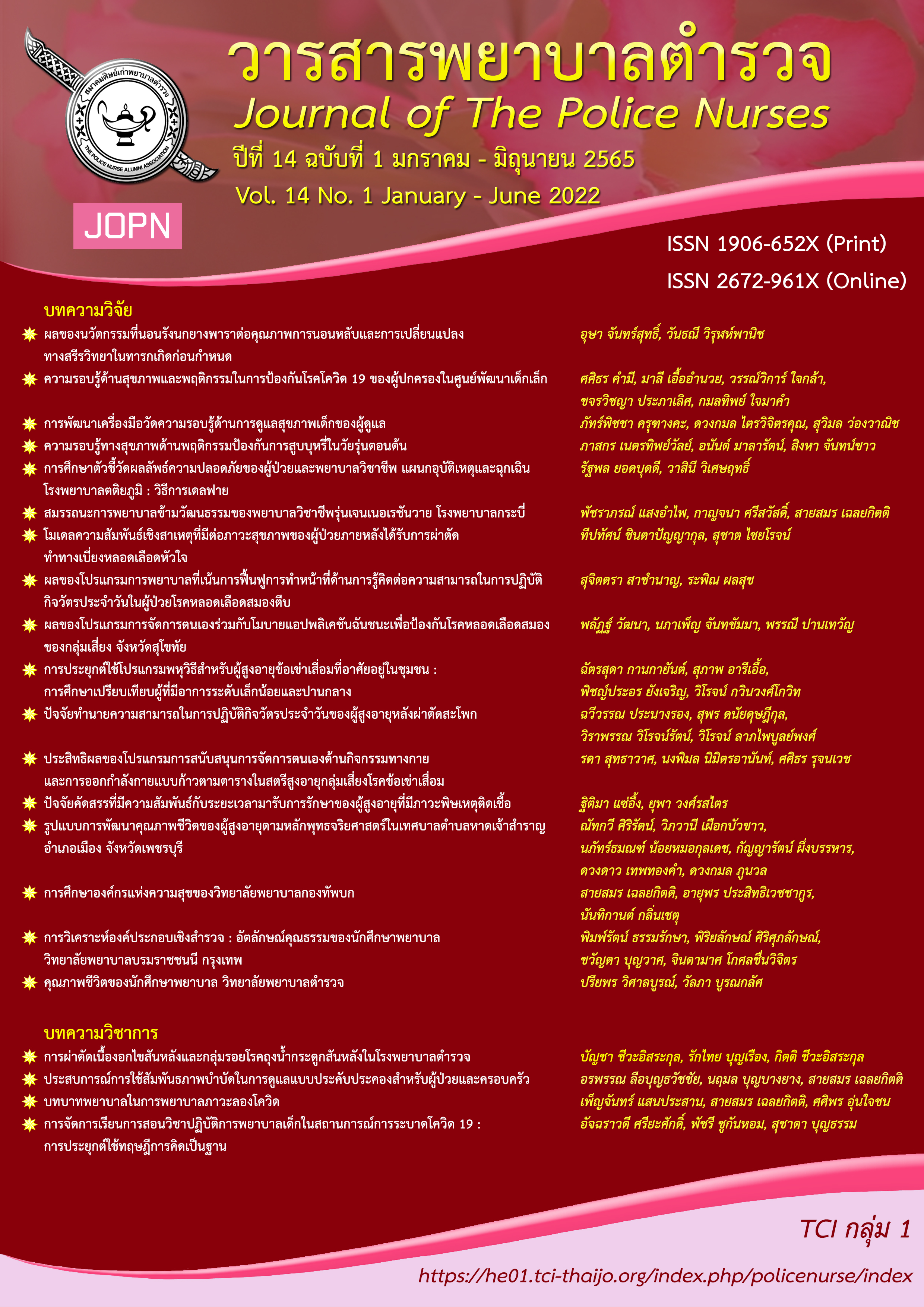ผลของนวัตกรรมที่นอนรังนกยางพาราต่อคุณภาพการนอนหลับและการเปลี่ยนแปลงทางสรีรวิทยาในทารกเกิดก่อนกำหนด
คำสำคัญ:
ที่นอนรังนกยางพารา, ทารกเกิดก่อนกำหนด, คุณภาพการนอนหลับ, การเปลี่ยนแปลงทางสรีรวิทยาบทคัดย่อ
การวิจัยกึ่งทดลองแบบไขว้กลุ่มนี้ทำเพื่อศึกษาผลของนวัตกรรมที่นอนรังนกยางพาราและเพื่อเปรียบเทียบคุณภาพการนอนหลับและการเปลี่ยนแปลงทางสรีรวิทยาในทารกเกิดก่อนกำหนดอายุครรภ์ 32-36 สัปดาห์ ขณะนอนบนที่นอนรังนกยางพาราและที่นอนรังนกผ้าอ้อม คัดเลือกกลุ่มตัวอย่างแบบเฉพาะเจาะจง จำนวน 23 ราย โดยให้ทารกนอนบนที่นอนรังนกด้วยการสุ่มตามแบบแผนการทดลองด้วยวิธีจับฉลากแบบไม่ใส่คืน บันทึกพฤติกรรมการหลับตื่นด้วยเทปวิดีทัศน์และบันทึกสัญญาณชีพทุก 10 นาที จากนั้นนำเทปวิดีทัศน์มาแปลผลเป็นระยะเวลาการนอนหลับโดยใช้แบบประเมินระยะหลับตื่นของทารกเกิดก่อนกำหนด ตรวจสอบความเที่ยงของแบบประเมินระยะหลับตื่นโดยการทดสอบความเท่าเทียมกันของการสังเกต ระหว่างผู้วิจัยกับผู้เชี่ยวชาญด้านการประเมินพฤติกรรมการหลับตื่นของทารกเกิดก่อนกำหนดและระหว่างผู้วิจัยกับผู้ช่วยวิจัย ได้ค่าความเที่ยงเฉลี่ยที่เห็นพ้องกันร้อยละ 95.0 และ 98.33 ตามลำดับ วิเคราะห์ข้อมูลด้วยการเปรียบเทียบค่าเฉลี่ยของระยะเวลาการหลับตื่นและสัญญาณชีพของทารกเกิด
ก่อนกำหนดในระหว่างนอนบนที่นอนรังนกยางพารากับที่นอนรังนกผ้าอ้อมโดยใช้สถิติทีคู่ (Paired t-test)
ผลการศึกษาพบว่า 1) คุณภาพการนอนหลับของทารกเกิดก่อนกำหนดขณะนอนบนที่นอนรังนกยางพาราสูงกว่าขณะนอนบนที่นอนรังนกผ้าอ้อม โดยทารกมีค่าเฉลี่ยระยะหลับรวมและระยะหลับลึกมากกว่าอย่างมีนัยสำคัญทางสถิติ (p < .05) ส่วนระยะหลับตื้นไม่แตกต่างกัน (p > .05) 2) การเปลี่ยนแปลงทางสรีรวิทยาของทารกเกิดก่อนกำหนด ได้แก่ ค่าเฉลี่ยของอัตราการหายใจ อัตราการเต้นของหัวใจและความอิ่มตัวของออกซิเจนในเลือดของทารกขณะนอนบนที่นอนรังนกทั้งสองประเภทแตกต่างกันอย่างมีนัยสำคัญทางสถิติ (p < .05) ส่วนค่าเฉลี่ยของอุณหภูมิร่างกายขณะที่นอนบนที่นอนรังนกทั้งสองประเภทไม่แตกต่างกัน (p > .05)
ดังนั้น การนำที่นอนรังนกยางพารามาใช้ในการดูแลทารกเกิดก่อนกำหนดที่เข้ารับการรักษาในโรงพยาบาล เป็นวิธีการหนึ่งในการดูแลเพื่อเพิ่มคุณภาพการนอนหลับ ทำให้ทารกมีระยะหลับรวมและระยะหลับลึกยาวนานขึ้น ในทางกลับกันเป็นการช่วยส่งเสริมการเจริญเติบโตและพัฒนาการทารกเกิดก่อนกำหนดให้มีความเหมาะสม
Downloads
References
Abdeyazdan, Z., Mohammadian-Ghahfarokhi, M., Ghazavi, Z., & Mohammadizadeh, M. (2016). Effects of nesting and swaddling on the sleep duration of premature infants hospitalized in neonatal intensive care units. Iranian Journal of Nursing and Midwifery Research, 21(5), 552-556.
Als, H. (1982). Toward a synactive theory of development: Promise for the assessment and support of infant individuality. Infant Mental Health Journal, 3(4), 229-243.
Altimier, L., & Phillips, R. M. (2013). The neonatal developmental care model: Seven neuroprotective core measures for family-centered developmental care. Infant Mental Nursing Review, 13, 9-12.
Blackburn, S. T., & Vadenberg, K. A. (1993). Assessment and management of neonatal neurobehavioral development. In C. Kanner, A. Brueggemeyer, & L. P. Gunderson (Eds.), Comprehensive neonatal nursing (pp. 1095-1130). Philadephia, PA: W. B. Saunders.
Boonya-bpichart, C., Vichitsukon, K., & Sithichai, K. (2007). The effect of nest on body temperature on low birth weight newborns. Siriraj Nursing Journal, 1(2), 1-10.
Calciolari, G., & Montirosso, R. (2011). The sleep protection in the preterm infants. The Journal of Maternal-Fetal & Neonatal Medicine, 24(1), 12-14.
El-Nagger, N. S. M., & Bayoumi, O., R. (2016). Effect of applying nesting technique as a developmental care on physiological functioning and neurobehavioral organization of premature infants. Life Science Journal, 12(1),79-92.
Gardner, S. L., & Lubchenco, L. O. (1998). The neonate and the environment: Impact on development. In G. B. Merenstein & S. L. Gardner (Eds.), Handbook of neonatal intensive care (pp. 211-212). St. Louis: Mosby.
Gorzilio, D. M., Garrido, E., Gaspardo, C. M., Martinez, F. E., & Linhares, M. B. M. (2015). Neurobehavioral development prior to term-age of preterm infants and acute stressful events during neonatal hospitalization. Early Human Development, 91(12), 769-775.
Holditch-Davis, D., & Blackburn, S. T. (2014). Neurobehavioral development. In L. C. Kenner & J. W. Lott (Eds.), Comprehensive neonatal nursing (pp. 689-721). New York, NY: Springer.
Kihara, H., & Nakamura, T. (2013). Nested and swaddled positioning support in the prone position facilitates sleep and heart rate stability in very low birth weight infants. Original Research, 3 ,11–14.
Kitase, Y., Sato, Y., Takahashi, H., Shimizu, M., Ishikawa, C., Yamamoto, H., & Hayakawa, M. (2017). A new type of swaddling clothing improved development of preterm infants in neonatal intensive care units. Early Human Development, 112, 25-28. https://dx.doi.org/10.1016/j.earlhumdev.2017.06.005
Kitpreedaborrisut, B. (2006). Techniques for creating data collection tools for research (6th ed). Bangkok: Sri-anan.
Mony, K., Vindra, S., Krishnakumar, D., & Vijaya, R. (2018). Effect of nesting on sleep pattern among preterm infants admitted in NICU. Biomedical Research, 29(10), 1994-1997.
Nakklinkul, P. (2003). Effect of quiet hour provision on sleep period of premature infants (Master of nursing science program, pediatric Nursing). Graduate School, Chiang Mai University, Chiang Mai.
Nuansate, S., Chairat, S., & Poungsuwan, S. (2017) Guideline for marketing mix development of healthy latex pillo products of phreak Har farmer group for sustainable promote latex privatiqation product (Research Reports, Faculty of Management Technology) Rajamanggala University of Technology Srivijaya. Nakhonsithammarat.
Pongsaranunthakul, Y. (2016). Nursing care for preterm infants. In W. Thampanichawat, S. Rungamornrat, & S. Payakkaraung (Eds.), Nursing care of high-risk newborn (pp 35-50). Bangkok: Pre-wan.
Sandeep, K. G., Yogesh, K., & Jyoti. S. (2015). A study to assess and evaluate the effect of nesting on physiological parameters and comfort behavior of preterm infants admitted in NICU of selected hospitals in Punjab and Haryana. Research & Reviews: Journal of Nursing Science and Practice, 5(2), 8-11.
Songnuy, K. (2021). The effect of nursing care using environmental management with Apaiparit chant listening on the sleep quality of preterm infants (Master of nursing science program, pediatric Nursing). Graduate School, Prince of Songkhla University, Songkhla.
Srisawet, S., Daramas, T., & Pookboonmee, R. (2013). Effects of Mozart’s music on heart rate, respiratory rate, oxygen saturation, and sleep duration of preterm infants. Ramatibodi Nursing Journal, 19(2), 221-234.
Thampanichawat, W. (2016). Developmental care for preterm infants. In W. Thampanichawat, S. Rungamornrat, & S. Payakkaraung (Eds.), Nursing care of high-risk newborn (pp 51-76). Bangkok: Pre-wan.
Thanacharoenpipat, P. (2001). Effects of positioning on duration of sleep among premature infants (Master of nursing science program, pediatric Nursing). Graduate School, Chiang Mai University, Chiang Mai.
Zarei, K., Shariat, M., Nikafs, N., & Sepaseh, H. (2018). Correlations of handling procedures and sleep patterns of the infants admitted to the Neonatal Intensive Care Unit. Iranian Journal of Neonatology, 9(3), 35-41.
Downloads
เผยแพร่แล้ว
How to Cite
ฉบับ
บท
License
Copyright (c) 2022 วารสารพยาบาลตำรวจ

This work is licensed under a Creative Commons Attribution-NonCommercial-NoDerivatives 4.0 International License.
ผลงานที่ได้ตีพิมพ์แล้วจะเป็นลิขสิทธิ์ของวารสารพยาบาลตำรวจ














